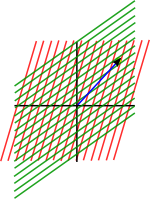Bilinearform
As a bilinear form refers to linear algebra, a function which maps two vectors and a scalar value that is linear in its two arguments.
The two arguments may come from different vector spaces, which, however, a common Skalarkörper must be based; a bilinear form a picture. A bilinear form is a linear form with respect to both its first and its second argument, and thus in particular a multi- linear form with two arguments.
The value of a positive definite bilinear form on at least two vectors is usually written as.
- 5.1 change of basis
- 5.2 Examples / Features
Definition
There are vector spaces over a field (or more generally a left- module and a right module over a commutative ring not necessarily ).
A picture
Is called bilinear if:
There are, and.
Symmetry properties in the case V = W
When both of the arguments of the bilinear of the same vector space derived is referred to as the shape value of the vector x (relative to B). The bilinear form may have additional symmetry properties:
- A bilinear form is called symmetric if
- A bilinear form is called alternating if all form values disappear with respect to, ie, if
- A bilinear form is called anti-symmetric or skew-symmetric if
Each alternating bilinear form is also antisymmetric. Each antisymmetric bilinear form is alternating: Is what is true, for example, for and, the converse also holds. Looking at general modules over any commutative ring, these two terms are equivalent if the target module has no 2- torsion.
Examples
- An inner product on a real vector space is a nondegenerate, symmetric positive definite bilinear form.
- An inner product on a complex vector space is not a bilinear form, but a sesquilinear. Summing but as a real vector space, then
- There is a canonical nondegenerate bilinear form
Ausartungsraum
Definition of Ausartungsraums
Be a bilinear form. The amount
Is a subspace of law and is called core or right radical of the bilinear form. Accordingly, ie
Links core or links radical. If a bilinear symmetric so agree right core and core links and is called this space the Ausartungsraum of.
The notations and are used with analog definition for subsets respectively.
Non- degenerate bilinear form
Each bilinear form defined two linear maps
And
Right and left nucleus, the nuclei of these images:
Are both cores trivial ( the two images and therefore injective ), so called non- degenerate bilinear form, the non- degenerate or perfect pairing. Otherwise, the bilinear form is called nondegenerate or degenerate.
The bilinear form is thus if and only non- degenerate if the following applies:
- For each vector there exists a vector with and
- To each vector there exists a vector with
Are finite and so are the pictures and for a non- degenerate pairing isomorphisms.
If the bilinear symmetric, so it is accurate then non- degenerate if their Ausartungsraum is the zero vector space.
Coordinate representation
For finite-dimensional and one can choose bases and.
The matrix representing a bilinear form is now
Are the coordinates and vectors and so applies
Where the matrix product of a matrix yields, ie a body member.
Conversely, any matrix, defined as
A bilinear form.
Change of basis
Are more and bases of, and to continue the change of basis matrix from to. Then the matrix of results in the new basis as
The matrices and are then called congruent.
Examples / properties
- The standard scalar product in has respect to the standard basis as the matrix is the identity matrix.
- When V = W and V and the same base for W is used, then: The bilinear form (anti ) is symmetrical if and only if the matrix ( anti) is symmetrical. It is alternating if and only if the matrix is anti-symmetric and all elements on its diagonal = 0 are
- The mapping is a bijection of the space of bilinear forms on the - matrices. If we define the sum and scalar multiplication of bilinear forms on canonical way ( ), this bijection is also a Vektorraumisomorphismus.
- For symmetric bilinear forms on vector spaces of finite dimension, there exists a basis in which the matrix representing diagonal form has (in case). (see Gram- Schmidt's orthogonalization for the special case of positive definite bilinear forms )
- If you continue, you can find a basis, in addition to the diagonal only items 1, -1 and 0 occur ( inertia Sylvester's theorem )
Further remarks
- Bilinear forms correspond to linear maps; see tensor.
- If the mapping is not necessary in Skalarkörper K, but in an arbitrary vector space, it is called a bilinear mapping.
- The generalization of the concept of bilinear form on more than two arguments is called multi- linear form.
- Over the field of complex numbers can often calls linearity in a and semi -linearity in the second argument; instead of a bilinear form, we obtain a sesquilinear. In particular, an inner product on a real vector space a bilinear form on a complex vector space is only a sesquilinear.









